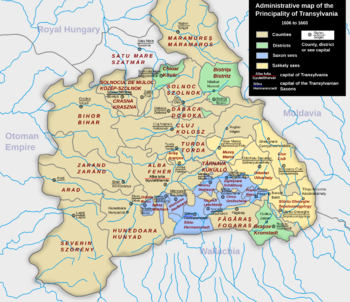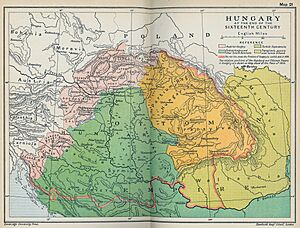Principality of Transylvania (1570–1711) facts for kids
Quick facts for kids
Principality of Transylvania
Principatus Transsilvaniae
|
|||||||||
|---|---|---|---|---|---|---|---|---|---|
| 1570–1711 | |||||||||

Administrative map of the Principality of Transylvania, 1606–60
|
|||||||||
| Status | Vassal state of the Ottoman Empire; Hungarian crown land; Polish fiefdom |
||||||||
| Capital | Alba Iulia (Gyulafehérvár) 1570–1692 Cibinium (Nagyszeben/Hermannstadt/Sibiu) 1692–1711 |
||||||||
| Common languages | Latin (in administration, science and politics) Hungarian (vernacular, language of Diet and legislation) German (vernacular, business, some official functions and instruction) Romanian, Ruthenian (vernacular). |
||||||||
| Religion | Catholicism (both Latin and Romanian Greek Catholicism), Calvinism, Lutheranism, Eastern Orthodoxy, Unitarianism, Judaism |
||||||||
| Demonym(s) | Transylvanian | ||||||||
| Government | Elective principality | ||||||||
| Rulers | |||||||||
|
• 1570–1571 (first)
|
John II Sigismund Zápolya | ||||||||
|
• 1704–1711 (last)
|
Francis II Rákóczi | ||||||||
| Legislature | Transylvanian Diet | ||||||||
| History | |||||||||
|
• Treaty of Speyer
|
16 August 1570 | ||||||||
|
• Bocskai uprising
|
28 September 1604–23 June 1606 | ||||||||
| 23 June 1606 | |||||||||
|
• Peace of Nikolsburg
|
31 December 1621 | ||||||||
|
• Diploma Leopoldinum
|
16 October 1690 | ||||||||
| 26 January 1699 | |||||||||
| 15 June 1703 – 1 May 1711 | |||||||||
|
• Peace of Szatmár
|
29 April 1711 | ||||||||
|
|||||||||
| Today part of | Romania Hungary Slovakia Ukraine |
||||||||
The Principality of Transylvania was a special state in Europe that existed from 1570 to 1711. It was mostly ruled by Hungarian princes. Even though it was largely independent, it was also a "vassal state" of the Ottoman Empire. This means it had to pay tribute and follow some rules set by the Ottoman sultans. At other times, the Habsburg family also had some control over the area.
Transylvania was important because it kept Hungarian traditions alive when other parts of Hungary were under different rulers. It also protected the interests of Hungarians against the powerful Habsburgs. The state was mostly Protestant, which was unusual for the time. After a period of wars, it became part of the Habsburg monarchy.
Contents
How Transylvania Became a Principality
The Start: Battle of Mohács and Hungary's Division
In 1526, a big battle happened at Mohács. The army of the Ottoman Empire, led by Sultan Suleiman, defeated the Hungarian forces. The young King Louis II of Hungary died in this battle.
After the king's death, two people claimed the throne: John Zápolya and Ferdinand from the Habsburg family. John Zápolya got help from Sultan Suleiman. When John Zápolya died in 1540, the Ottomans took control of central Hungary. They said they were protecting John Zápolya's son, John II Sigismund.
Hungary was then split into three parts:
- Royal Hungary in the west and north.
- Ottoman Hungary, directly ruled by the Ottomans.
- The Eastern Hungarian Kingdom, which was under Ottoman influence. This area later became the Principality of Transylvania.
For nearly 200 years, both Austrian (Habsburg) and Turkish influences tried to control Transylvania. The Hungarian nobles in Transylvania had to be very clever to keep their independence.
Early Rulers and Religious Freedom
From 1541 to 1551, John II Sigismund's mother, Isabella, ruled Transylvania. Then, for five years, the Habsburgs took control. But in 1556, the Zápolya family got Transylvania back.
Because Transylvania was outside the control of the Catholic Church, new religious ideas like Lutheranism and Calvinism grew there. In 1563, a doctor named Giorgio Blandrata came to the court. He had radical religious ideas and influenced young John II and a bishop named Francis David. They both became Unitarians, a group that did not believe in the Trinity.
In 1568, the Edict of Torda was passed. This was a very important law because it gave people the freedom to choose their religion. This was one of the first times such a law was made in Christian Europe. However, this freedom was mainly for Lutherans, Calvinists, Unitarians, and Catholics. Eastern Orthodox Christians were "tolerated" but did not have the same legal protections.
The Principality of Transylvania: A Golden Age
The Principality of Transylvania officially began in 1570. John II Sigismund gave up his claim to be King of Hungary in the Treaty of Speyer. Instead, he became the Prince of Transylvania. This treaty also said that Transylvania was still part of the Kingdom of Hungary in a legal sense.
After John II died in 1571, the Báthory family took over. They ruled Transylvania as princes, sometimes under the Ottomans and sometimes under the Habsburgs. Their rule marked the start of Transylvania as a semi-independent state.
Powerful Princes and Important Treaties
Stephen Báthory was the first strong prince of independent Transylvania. He was a Hungarian Catholic who later became King of Poland. He promised to keep religious freedom, but he made the rules stricter over time.
Later, under Prince Sigismund Báthory, Transylvania joined the Long War. This war was against the Turks but became a complex fight involving Transylvania, the Habsburgs, the Ottomans, and Wallachia. After 1601, the Habsburgs briefly ruled Transylvania. They tried to make the people more German and bring back Catholicism.
From 1604 to 1606, a Hungarian nobleman named Stephen Bocskay led a successful rebellion against Austrian rule. He was elected Prince of Transylvania in 1603. In 1606, he achieved the Peace of Vienna. This treaty gave religious freedom and political independence to Transylvania. It also said that Transylvanians could elect their own princes.
Transylvania's Golden Era
Under Bocskay's successors, Transylvania had its best period. This was especially true during the reigns of Gábor Bethlen (1613–1629) and George I Rákóczi.
Gábor Bethlen worked hard to protect his people from the emperor. He also gained fame by supporting the Protestant cause in Europe. He fought the emperor three times and was even declared King of Hungary twice. Through the Peace of Nikolsburg in 1621, he confirmed the religious freedoms and gained more land for Transylvania.
George I Rákóczi was also very successful. His biggest achievement was the Peace of Linz in 1645. This treaty again forced the emperor to confirm the religious freedoms for Protestants.
Both Gabriel Bethlen and George I Rákóczi greatly supported education and culture. Their time is called the "golden era" of Transylvania. They spent a lot of money making their capital, Alba Iulia, beautiful. Alba Iulia became a major center for Protestantism in Eastern Europe. During their rule, Transylvania was one of the few places in Europe where Catholics, Calvinists, Lutherans, and Unitarians lived together peacefully. These were the "officially accepted religions." The Orthodox Church was tolerated but did not have the same legal status.
The Decline of the Principality
In 1660, the city of Nagyvárad fell to the Ottomans. This marked the beginning of Transylvania's decline. The Habsburgs wanted to control Transylvania to stop the Ottoman threat.
In 1661, the Transylvanian diet (parliament) declared that Transylvania was breaking away from the Ottomans. They asked Vienna for help. But a secret agreement between the Habsburgs and Ottomans led to more Habsburg influence.
After the Ottomans were defeated at the Battle of Vienna in 1683, the Habsburgs slowly took over Transylvania. In 1699, the Treaty of Karlowitz officially made Transylvania part of Habsburg-controlled Hungary. From 1711 onwards, Habsburg control became complete, and princes were replaced by governors.
Who Lived in Transylvania?
The Ruling System: Three Nations
Until 1691, Transylvania was ruled by a system called the "Unio Trium Nationum" (Union of the Three Nations). These "nations" were:
- The Hungarian nobility.
- The Saxon (German) townspeople.
- The Székely peasant-soldiers.
These three groups had political rights. However, a large part of the population, especially Orthodox Romanians, did not have any civil or political rights.
The Parliament and Peasants
The "Union of the Three Nations" was a pact made in 1438. It was formed by the Hungarian nobles, Saxon patricians, and free Székely soldiers. This union was created to protect their interests against peasant revolts.
In this feudal parliament, peasants (whether Hungarian, Saxon, Székely, or Romanian) were not represented. They did not benefit from the laws because common people were not considered members of these "nations."
The "Three Nations" worked together to maintain their power. They formed a common front against the mostly Romanian peasantry.
Population Changes Over Time
Historians have different ideas about the exact population numbers in Transylvania.
- In 1536, a Hungarian leader named Nicolaus Olahus wrote that four groups lived in Transylvania: Hungarians, Székelys, Saxons, and Vlachs (Romanians).
- Some historians believe Romanians were the majority even in the Middle Ages. Others think Hungarians were more numerous until the mid-1600s.
- For example, some estimates suggest that in 1595, out of 670,000 people, 52% were Hungarians, 28% Romanians, and 19% Germans.
- By 1600, some historians say Romanians, who were mostly peasants, made up more than 60% of the population.
Wars and diseases had a big impact on the population. Between 1657 and 1661, Transylvania was badly damaged by war. Many villages were destroyed, and people were killed or captured. This caused huge losses in the population.
Official Austrian estimates from 1712–1713 show the population as: 47% Hungarians, 34% Romanians, and 19% Saxons. Other estimates for the early 1700s suggest Romanians were around 50% of the population.
Why People Moved: Immigration and Emigration
Historians also debate how much people moved into and out of Transylvania.
- Some Hungarian historians say many Romanians moved into Transylvania.
- Romanian historians argue that more people left Transylvania for Moldavia and Wallachia.
Transylvania's peace and economic recovery after wars attracted new settlers. The demand for workers also encouraged people to move there, mainly from Moldavia and Wallachia. Prince Michael I Apafi's good economic policies helped the population grow. He also welcomed people of different religions.
An Ottoman traveler named Evliya Çelebi wrote in the 1600s that Romanian peasants moved to Transylvania. He said they did this because rulers in Romanian lands were harsh, while Transylvania had justice, legal order, and low taxes.
Many reports from the 1600s show that Romanian serfs (peasants tied to the land) fled to Transylvania. They escaped heavy taxes and harsh conditions in Moldavia and Wallachia. For example, in 1668, the ruler of Wallachia wrote to Prince Michael I Apafi about many Romanian villages that had escaped to Transylvania because of high taxes.
On the other hand, many Romanians also left Transylvania for Moldavia and Wallachia. This happened even in the Middle Ages. After a peasant rebellion in 1514, and due to religious persecution and harder living conditions, more Romanians left. Laws in Transylvania also became less fair for Romanians. For example, after 1552, it was easier for Romanians to be accused in court compared to Hungarians and Saxons.
In the late 1600s, more people left Transylvania due to high taxes and wars. Famines and diseases like the plague also reduced the population. Many Protestant families (Hungarians, Székelys, Saxons) were forced to flee because of religious conflicts.
Romanians were not directly affected by the Counter-Reformation, but their Orthodox faith meant they had fewer political, economic, and cultural rights. This made them more likely to move to Moldavia and Wallachia, where they could have more opportunities. Many Romanian nobles and common people moved south and east of the Carpathian Mountains to these Romanian states.
Food shortages and famine in the late 1600s also caused people to leave. By the 1700s, the movement of Romanians to Moldavia and Wallachia increased even more.
Images for kids
-
The division of the Kingdom of Hungary between the Ottoman and Habsburg empires after the Battle of Mohács in 1526.
See also
 In Spanish: Principado de Transilvania para niños
In Spanish: Principado de Transilvania para niños






